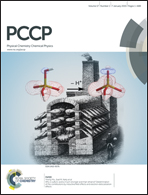Fullerene cyanation does not always increase electron affinity: an experimental and theoretical study
Abstract
The electron affinities of C70 derivatives with trifluoromethyl, methyl and cyano groups were studied experimentally and theoretically using low-temperature photoelectron spectroscopy (LT PES) and density functional theory (DFT). The electronic effects of these functional groups were determined and found to be highly dependent on the addition patterns. Substitution of CF3 for CN for the same addition pattern increases the experimental electron affinity by 70 meV per substitution. The synthesis of a new fullerene derivative, C70(CF3)10(CN)2, is reported for the first time.


 Please wait while we load your content...
Please wait while we load your content...